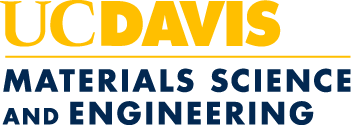Federally-Funded Graduate Student Assistance
The Graduate Assistantships in Areas of National Need (GAANN) program provides fellowships through academic departments to assist graduate students with excellent records who demonstrate financial need and plan to pursue the highest degree available in their course study at the institution in a field designated as an area of national need. These fields include biology, chemistry, computer and information sciences, engineering, mathematics, nursing, physics and educational assessment, evaluation and research.
The GAANN program at the Department of Materials Science and Engineering
The GAANN program at the Department of Materials Science and Engineering (MSE) recruits Ph.D. students from undergraduates with superior ability and demonstrated financial need. Our interdisciplinary program explicitly seeks to increase the pool of traditionally underrepresented students by soliciting applications from disciplines with larger student populations, such as the biological and physical sciences, which therefore have larger numbers of the targeted groups. These students would normally enter the work force with their bachelor’s degree or might pursue graduate studies in other majors.
All students in good standing are supported throughout their studies and graduate with a Ph.D. within five years. GAANN fellowships support the first year for students with non-traditional academic backgrounds, when they take courses that provide the expertise expected of incoming students with conventional (MSE or chemical engineering) training. Fellows receive at least one year of supervision in teaching at UC Davis and at a local community college, as well as professional advising. We encourage participation in a year-long program focusing on professional development and leadership and assisting graduate students with job placement in academia or industry.
Lab exercises developed by MSE GAANN fellows for the chemistry department at American River College:
- 1. Colligative Properties
- In this lab, colligative properties are examined by looking at the boiling point elevation of water in the presence of different amounts of salt (NaCl). The data collected is used to calculate the van’t Hoff factor.
Lab Procedure.
Lab Report Template. - 2. Experimental Determination of Avogadro's Number
-
This lab uses basic principles of electrochemistry to perform an experimental determination of Avogadro’s number. Using a simple galvanic cell and ammeter, combined with the mass change in the copper electrode, students are able to calculate Avogadro's number.
Lab Procedure. - 3. Stereochemistry
-
This lab and attendant readings help the student to understand how the spatial arrangement and bonding geometry of atoms in a molecule give rise to distinct molecular structures. The concepts of structural isomerism, chirality and conformational isomerism are explored for organic molecules. The lab exercises use molecular model kits (no wet lab).
Prelab Reading.
Lab Procedure.
Stereochemistry Lecture. - 4. Electrochemistry
- Principles of electrochemistry are demonstrated by constructing a simple battery using copper/zinc electrodes and electrolyte solutions of Gatorade, lemons, potatoes and soda. The electrolytic properties of each solution are compared and the reaction quotient determined.
Prelab Reading and Lab Exercise. - 5. Liquid Crystal Lab
- This lab investigates two forms of liquid crystals to see how their structure and physical properties are affected by outside stimuli such as temperature and pressure.
Lab Procedure. - 6. Investigating Silver Nanoparticles
- This lab analyzes a colloidal silver solution synthesized via chemical reduction using silver nitrate and sodium borohydride to observe the change in properties (absorption, color) that occurs between bulk-scale and nano-scale materials.
Lab Procedure. - 7. Electroplating
- Electroplating involves the deposition of a metal onto an object composed of a different metal. In this lab you will be electroplating zinc onto a penny and copper onto a nickel, then calculating the number of moles of each metal deposited onto the coins.
Lab Procedure. - 8. Iodine Clock and an Introduction to Kinetics
- This lab uses the iodine clock reaction to introduce students to kinetics. Through modifying the temperature and reactant ratios, students can qualitatively observe the Arrhenius equation and reaction orders of the reactants.
Lab Procedure.
Introduction to Chemical Kinetics.
Slideshow Summary. - 9. Spectrophotometric Determination of Phosphates in Water
- This lab uses spectrophotometry, a method that determines how much a chemical compound absorbs and transmits light, to measure the concentration of pollutants in water.
Lab Procedure.

